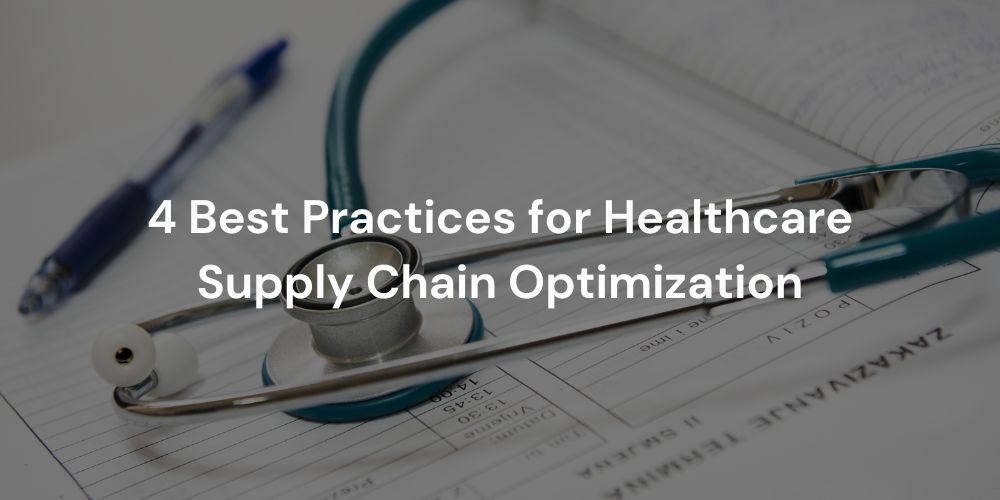4 Best Practices for Healthcare Supply Chain Optimization


Explore practical recommendations aimed at assisting healthcare providers in addressing challenges within the healthcare supply chain. From optimizing design and networks to forecasting demand and managing inventory, key areas are examined to mitigate disruptions, enhance patient care, and achieve cost efficiencies.
Efficient healthcare supply chain management is pivotal in ensuring quality care delivery and favorable patient outcomes. The vulnerabilities exposed during the COVID-19 pandemic underscore the criticality of optimizing healthcare logistics.
Read more: Innovative Solutions in Healthcare Supply Chain
1. Enhancing Supply Chain Design and Network Optimization
Evaluate existing design and distribution networks to uncover prospects for optimizing the healthcare supply chain.
The COVID-19 crisis prompted a reassessment of the viability of just-in-time inventory management within healthcare systems. Lean inventory practices, while beneficial under standard conditions, could lead to capacity limitations and amplify the risk of medical product scarcity during emergencies.
Tyler Ross, Novant Health’s Director of Supply Chain Operations, highlighted the necessity of building robust contingency plans to tackle shortages proactively:
“I hope coming out of this we move from traditional just-in-time methodology for inventory management and product availability. Just in time is important but again we’re not retail, so we need some sort of safety valve to absorb disruption.”
However, excessive inventory, lacking efficient monitoring, poses the risk of wastage due to expired or misplaced items, potentially compromising patient safety. Recent studies have indicated that operating rooms stock an average of 13% of products that reach expiration on their shelves.
Collaboration among providers, suppliers, and distributors is paramount for optimizing the healthcare supply chain. Together, they can examine existing distribution networks, identifying weaknesses uncovered during COVID-19. This collective effort aims to fortify the medical supply chain, ensuring heightened patient safety, superior quality control, and optimized costs.
2. Demand Forecasting and Inventory Management
To ensure effective demand prediction and planning, assess the current state of system integration and data exchange to ascertain the accuracy and timeliness of analytics. Utilize predictive analytics and advanced forecasting techniques to predict demand accurately. Understanding consumption patterns and seasonal variations helps optimize inventory levels, minimize excess stock, and prevent shortages. Employ just-in-time inventory strategies and automation for streamlined management.
In a survey conducted by EY among major U.S. health systems, 95% of participants expressed a desire to enhance demand planning. Surprisingly, more than half of them admitted to not utilizing any specific system for such planning. According to a survey by Accenture targeting supply chain executives, 26% credited the improvement in demand forecast accuracy to their utilization of cloud-based systems.
Members of the SMI, discussing their primary priorities in healthcare supply chain management for 2023, emphasized the necessity for “authentic patient-level demand planning, empowering the transmission of predictive demand indicators to manufacturers.” They unanimously agreed that fostering “precise and comprehensive data exchange between providers and industry counterparts” stands as “an absolute imperative, paving the way for enhanced forecasting and disaster preparedness.”
Authors of the report “Building Resilience into the Nation’s Medical Product Supply Chains” (2022) underscored the pivotal role of transparency in medical supply chains. They stressed that “the more transparent stakeholders are regarding medical product supply chains, the better equipped they become in identifying vulnerabilities and proactively mitigating, preparing for, and responding to potential disruptions.” Further emphasizing this point, they highlighted the importance of converting data into actionable information to aid decision-makers effectively.
Achieving such data sharing requires integrated digital solutions bridging the gaps between healthcare providers and suppliers. This facilitates seamless communication and collaboration, empowering informed decision-making.
The Cleveland Clinic, renowned for its adept handling of supply chain challenges, attributed its success to collaborative relationships with suppliers and robust data sharing. The organization’s implementation of a resilience program for supplier fulfillment monitoring, coupled with a bidirectional inventory visibility tool with suppliers, earned it recognition in the Gartner Healthcare Supply Chain Top 25 for 2022.
Read more: Overcoming Challenges of Data Integration in Healthcare
3. Transportation and Warehousing Optimization
Enhance ties with suppliers and distribution networks by initiating supplier diversification strategies, emphasizing the preference for manufacturers located on-shore or near-shore.
Reducing the supply chain’s length and simplifying logistical intricacies can significantly mitigate potential obstacles in acquiring necessary supplies.
A Deloitte survey gauging the plans of chief financial officers (CFOs) to combat future supply disruptions revealed that 69% anticipate an increase in source diversification within the next three years. Notably, 39% indicated a specific inclination toward augmenting their sourcing from North American suppliers.
When venturing into novel supplier relationships and exploring new healthcare logistics networks within the medical supply chain, careful consideration of the cost implications tied to altering sourcing locations is crucial. Deloitte advises financial leaders to reevaluate the “total landed costs” for supplies, encompassing heightened expenses related to quality, inspections, duties, and handling.
In pursuit of achieving better control over healthcare supply chain management and striving towards optimization, certain health systems have embraced a self-distribution strategy. In a survey conducted among health systems, 100% of integrated delivery networks (IDNs) equipped with consolidated service centers (CSCs) unanimously expressed their belief that this approach “aided their response to the pandemic.”
For healthcare systems opting for a self-distribution framework, pivotal factors include implementing inventory management technologies for warehouses/CSCs and honing healthcare logistics capabilities, particularly in transporting supplies from warehouses to facilities.
Banner Health’s collaboration with its supplier, Johnson & Johnson, demonstrates the advantages of leveraging warehouse/CSC capabilities through joint efforts. Their collaborative approach in analyzing decision points and purchase patterns led to substantial results in 2022, notably reducing daily shipments by several hundred and standardizing stocked products in the CSC, resulting in a notable 19% enhancement.
4. Continuous improvement and performance measurement
Assess the credibility, timeliness, and utility of available supply chain data and analytics within the organization.
Effective optimization, performance assessment, and continual improvement hinge upon precise data and analytics delivering actionable insights for informed decision-making.
A substantial 94% of surveyed hospital supply chain leaders attest that analytics contribute to reducing supply costs. Furthermore, 76% acknowledge that supply chain analytics elevate care quality, while 61% believe these analytics influence staff satisfaction and retention.
In instances where prevalent data issues exist within healthcare organizations, identifying the root cause of these issues becomes crucial. Common supply chain challenges include deficient system integration, isolated data repositories, manual product data capturing, and inadequate data analytics and reporting capabilities.
Many health systems and hospitals are surmounting conventional obstacles related to healthcare supply chain management by transitioning from legacy on-premise enterprise resource planning (ERP) systems to cloud-based ERP solutions.
Nevertheless, as cautioned by Pete Nelson, GHX’s General Manager of Global Alliances, the value of a cloud ERP system heavily relies on the quality of the data fueling it. While the allure of adopting a cloud ERP system may be strong, migrating flawed data may lead to erroneous decisions.
For an effective transition and to surmount historical supply chain issues, organizations will find merit in evaluating, enhancing, and refining their data before making the move.
Partnering with experienced entities adept at supporting successful transitions to cloud ERP and jointly establishing a singular source of reliable and comprehensive data forms a robust groundwork for optimizing the healthcare supply chain.
Read more: Big Data in Healthcare Industry: Benefits, Challenges, and Use Cases
Conclusion
Efficient healthcare logistics and supply chain processes are imperative to guaranteeing healthcare providers possess the essential resources for delivering top-notch care to patients. The 4 actionable strategies deliberated herein present healthcare supply chain management teams with a foundation to assess their prevailing supply chain mechanisms and pinpoint avenues for enhancement.
Through the utilization of technology, data analytics, and the adoption of best practices in supply chain management, healthcare organizations can forge more streamlined, durable, and economical supply chains. These enhancements not only enhance the organization’s efficacy but also yield positive effects on patient care, satisfaction, staff retention, and overall healthcare results.
